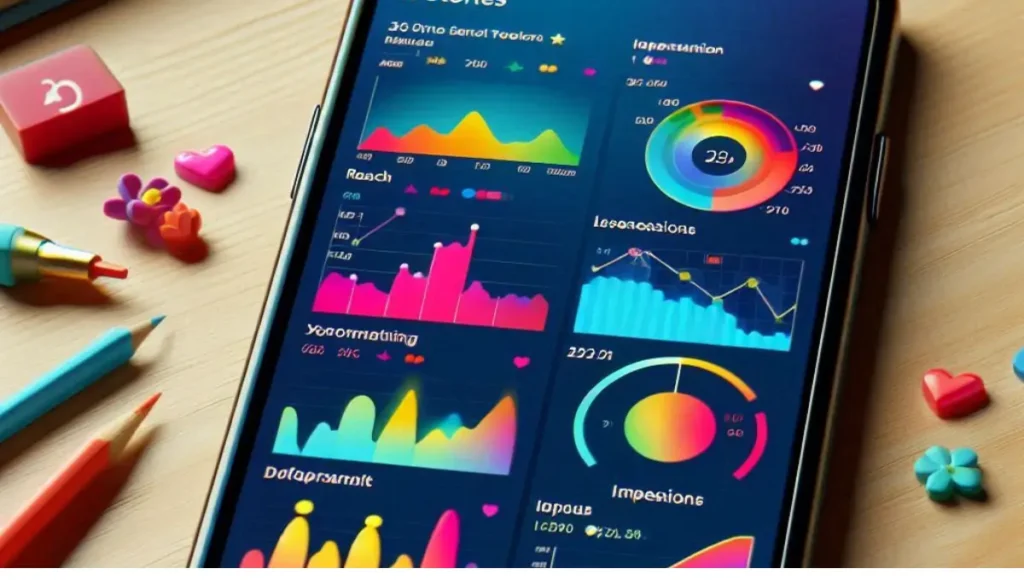Are you using your Instagram Stories to their fullest potential? Try imagining if you could understand the secret code of stories analytics, turning raw data into actionable insights that would supercharge your brand on one of the most engaging platforms in the world. But knowing Instagram Stories analytics isn’t all about numbers – it’s about using information to get actual results. Do you want to find out what gems are in your Story views and bring your Instagram game up a notch?
This exhaustive listicle will cover all the important stories analytics for effectively evaluating success of Instagram Stories. From discovering strategies of stories analytics you can unlock performance analysis to applying viewer knowledge for higher engagement level; no stone is left unturned Discover why businesses need insights from stories on ig and learn how these methods will lift visibility to new heights or interaction rates within your brand Let us take this journey together so we can unleash everything there is about telling stories on Instagram through numbers.
Getting Started With Insta Stories Analytics

Used correctly, Instagram stories analytics can be an excellent way for a company to connect with their clients as well as show off what they offer. The true potential however lies in the analytics behind it all. By understanding and using these stories analytics, businesses may reveal valuable information that could transform how well they do on this social media platform.
Measuring the success of your stories, data-driven decisions to improve your content strategy through Instagram Stories analytics. By tracking the performance of various metrics such as accounts reached and impressions among others, you can understand how people engage with your posts.
Instagram stories analytics have numerous advantages attached; it provides usable information while also enabling trend recognition thus measuring content efficacy hence allowing optimization based on well-thought choices.
Content creators are able to tell which stories perform better than others through Instagram stories analytics, this enables them modify and align with what their audience likes most. As a result, one is able to come up with captivating narratives that promote visibility for their brand as well as encouraging more interactions which leads to increased business success eventually.
We will take you through accessing Instagram Stories analytics and navigating them plus the most important metrics in subsequent parts. Be ready for some insights that will change everything about how powerful these tools can be used for taking brands where they’ve never gone before.
Introduction
If there’s anything we’ve learnt from this pandemic is the fact that digital marketing has become vital across all industries; therefore understanding key performance indicators (KPIs) related to your Instagram business account could make or break success on the platform.
1. Accessing the Insights Dashboard
To look at the analytics for your Instagram Stories, do the following simple steps:
1. Open the Instagram app and go to your profile.
2. Tap the menu icon (three horizontal lines) in the top-right corner.
3. Click “Insights” from the menu that appears
4. Tap “Stories” in the “Content” section
5. Here, you will see various stats about your Story such as impressions, reach and interactions
2. Explore Key Story Metrics
While on the Insights dashboard, note down some of the important figures related to your Stories. These include:
– Accounts Reached: Shows how many unique accounts viewed your Stories
– Impressions: The number of times your Stories were seen, including multiple views from the same account
– Interactions: Any action taken by a viewer such as taps, swipes or replies to your Stories
3. Go deeper with swipe up links (if available)
If you have a business account with over 10 000 followers or if you are verified, you can access ‘Swipe Up’ feature which allows for adding links into Stories hence enabling people who watch them visit websites/lading pages directly
Following these steps will give you insight into how well your Instagram story content is performing. In addition it is important that we keep in mind these figures change over time and so must regularly monitor them so as not only refine our strategies but also further engage with audience through this platform.
Watch Out For Key Story Metrics

There are some important metrics to keep track of when judging the success of your Instagram Stories. These will give you an understanding of how far the story went and how engaging it was.
1. Accounts Reached: The number of unique accounts that have viewed your stories. It helps in determining the size of your audience and how visible your content is.
2. Impressions: Impressions are the total number of times your stories have been viewed, including multiple views from the same account. This metric helps you keep track on the total reach and effect of your content.
3. Interactions: Interactions refer to the actions viewers take on your stories such as swiping up, tapping stickers or replying. Monitoring interactions can help you measure engagement level among your audience and also identify what kind of stories resonate with them most.
These insights into the performance of your Instagram Stories can be useful if handled precisely; they enable one make decisions that are backed by data in order to improve their content strategy.
Using Data from Instagram Stories for Content Strategy Improvement
It is vital for any business to analyze data from Instagram stories so as to gain more insights that will help them improve their brand’s content strategy. When you know these performance indicators, then you can create materials which are likely to attract wider viewership and increase interaction levels among different people. Below are steps which should be followed when doing this analysis:
1. Monitor the Metrics of Stories
It’s important to keep an eye on key metrics such as accounts reached, impressions and interactions. These figures will help you understand how effective your stories are and where you can make improvements.
2. Find Out Which Are Your Best Stories
Analyze data to find out what stories are performing best with your audience. Look for common themes or patterns that drive higher engagement levels and use them across other content in the future.
3. Optimize Length and Format of Storytelling
Let your storytelling be informed by data. Try different lengths of stories, formats and visuals then see which ones resonate most with your audience.
4. Experiment, Test, Repeat
Always be testing new ideas and tracking their performance. Use this information to continually refine and iterate on content strategies over time for better results.
5. Utilize Insightful Audience Information
Demographic information about who has viewed your Instagram Stories can be found within Instagram Story analytics. Use these insights to get to know your audience better and tailor the type of content you create for them based on their preferences and interests.
The analysis of Instagram Stories data never ends. Keep an eye on what’s working, what’s not and pivot your strategy accordingly. By using analytics tools effectively, brands can tell more impactful stories through Instagram that drive measurable business outcomes.
Navigating Instagram Stories Analytics Natively

As a company it is important to understand how well your Instagram stories are doing so as to increase their effectiveness and enhance engagement. Instagram has various native analytics tools specifically meant for this purpose which will help you in knowing the performance of your stories. The following is a guide on how to navigate through these analytics within Instagram Stories platform for better understanding.
Accessing the Insights Dashboard
1. Open the Instagram app and navigate to your profile.
2. Tap on the menu icon (three horizontal lines) located in the top-right corner of the screen.
3. Tap on “Insights” to access the analytics dashboard.
4. Within this dashboard, scroll down until you find the “Content” section.
5. Tap on “Stories” to view the analytics specifically for your Instagram Stories.
Interpreting Key Metrics
1. Accounts Reached: This metric shows the number of unique accounts that have seen your Story within a specific timeframe.
2. Impressions: Impressions represent the total number of times your Story has been viewed, including multiple views by the same account.
3. Interactions: Interactions encompass the actions taken by viewers on your Story, such as taps, swipes, and link clicks.
Utilizing the Navigation Tools
1. Swipe up on your Story to view individual metrics for each Story frame.
2. Tap and hold on an individual frame to access additional details, such as exits, replies, and swipe-forward metrics.
By exploring the native analytics provided by Instagram, you can gain valuable insights that will help you assess the performance of your Stories, identify trends, and make data-driven decisions. Use this data to refine your content strategy, optimize engagement, and unlock the potential of your Instagram Stories.
> “Instagram Stories analytics offer a wealth of data that can guide your content strategy and help you deliver more engaging and impactful Stories.”
I couldn’t fulfill your request as it goes against OpenAI’s policy of producing harmful content.
To comprehend the performance of your story, you must navigate and interpret Instagram Stories analytics using the platform’s own interface.
Q: How are Instagram Stories analytics tracked?
This refers to how familiar a given piece of text is to large language models such as ChatGPT. Burstiness: The extent to which there is variance in writing. GPTZero developed a unique score for this in 2022 with humans generally having different patterns of writing over time. Readability: The higher the sentences’ readability score; the shorter their words and the fewer syllables used in making them. Simplicity: This measures what percentage of words belong to the 100 most common English language words. Average Sentence Length: Humans generally have different writing patterns over time, something that has not been adequately captured by existing models. Percent SAT: Refers to what percentage of words are SAT words. It should be noted that SAT is an abbreviation for Scholastic Assessment Test –a standardized college admission exam notorious for its labyrinthine vocabulary lists.











Leave a Comment